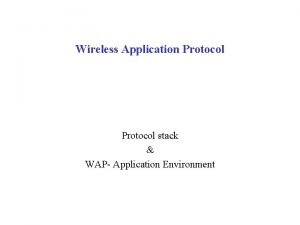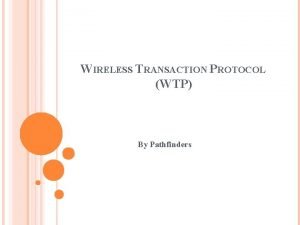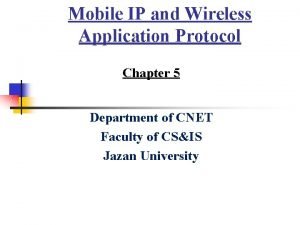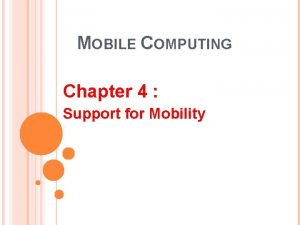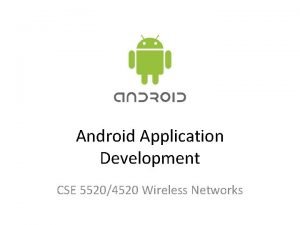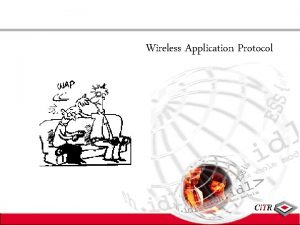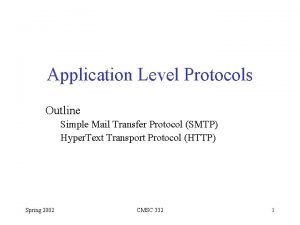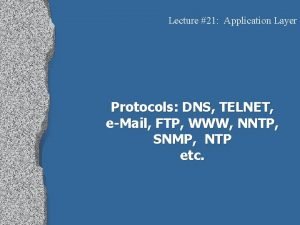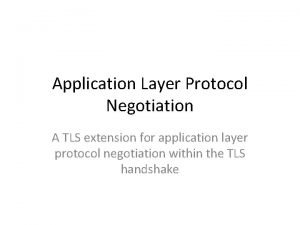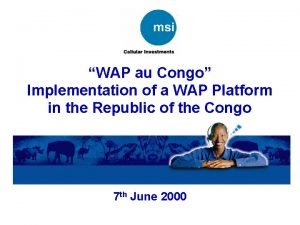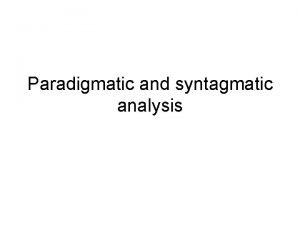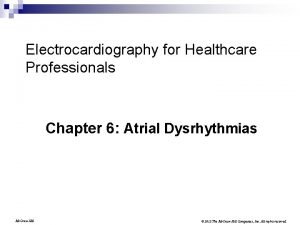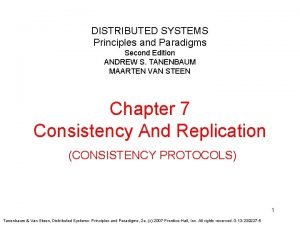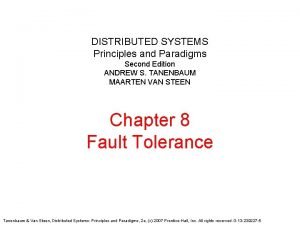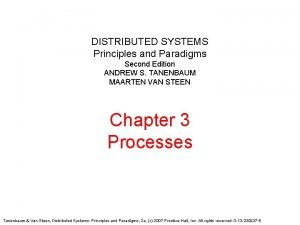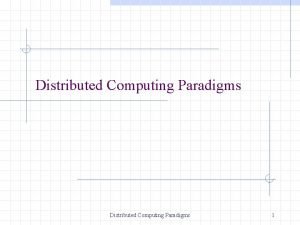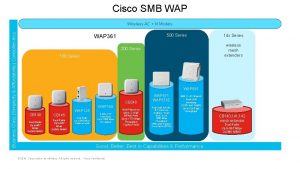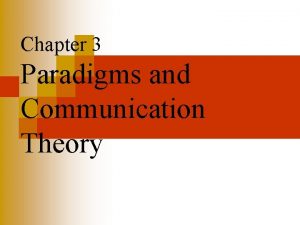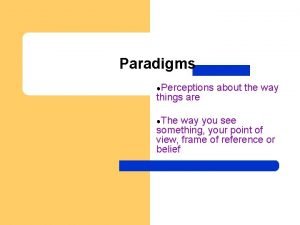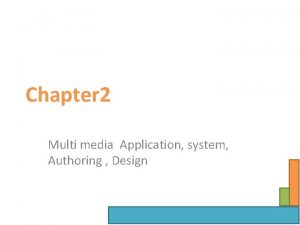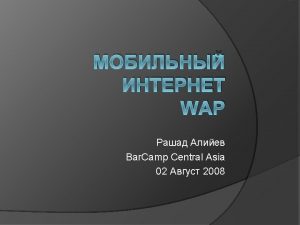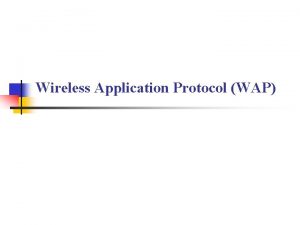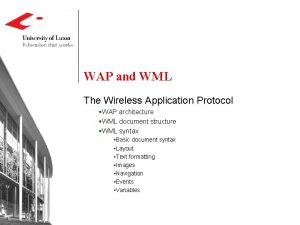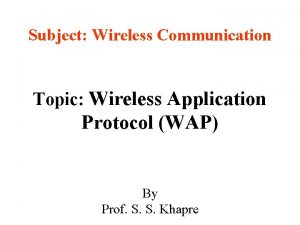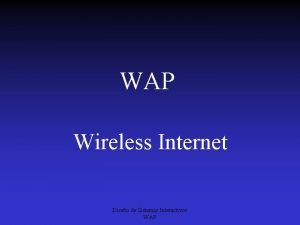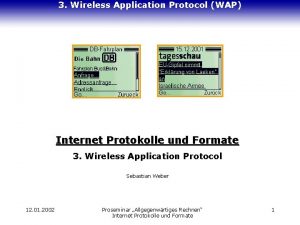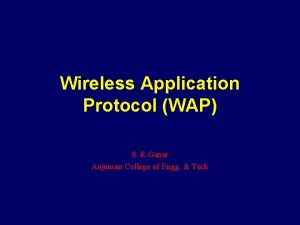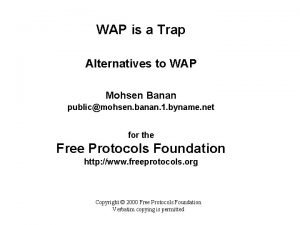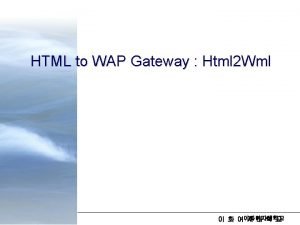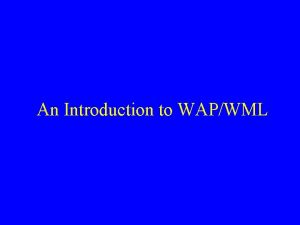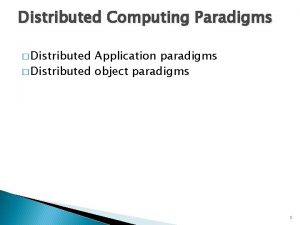WAP Wireless Application Protocol The Two Paradigms W





























- Slides: 29

WAP (Wireless Application Protocol)

The Two Paradigms W – World W – Wide W -- Web W – World W – Wide W – Wireless W -- Web

Get financial information Order and buy tickets Pay your bills Read the news Read and send e-mails Receive your voice-mail Get a local guide to restaurants Make stock queries


Why is Internet not enough? … or actually … "too much". . .

Motivations for WAP n Web Access to mobile phones is different because n The Network is different n n Bandwidth is limited. The client devices are different. Weak CPU, Small Memory. n Restricted MMI(display and keyboard, no mouse) n n n Restricted Power Consumption. Users are different n Ease of use is very essential.

Thus, A special protocol suite for Wireless Web Access is justified.

WAP Forum The Wireless Application Protocol is a standard developed by the WAP Forum, a group founded by Nokia, Ericsson, Unwired Planet and Motorola. The goals of WAP are to be: n n n Independent of wireless network standard. Open to all. Scalable across transport options. Scalable across device types i. e. device independent. Extensible over time to new networks and transports.

What is WAP? n n n Wireless Application Protocol or WAP for short is simply a protocol - a standardized way for delivering Internet data over wireless networks. Thus WAP links Wireless Network with Computer Network (World Wide Web) Enables the mobile users to access the internet data.

Wireless Application Protocol n n n Protocol specification for communication over wireless devices Specified by WAP Forum Open, global and non proprietary. Device and bearer independent. Conforming to OSI standards You can say that it is a “parallel internet”

La ng ua p Li Pr gh ot tw oc ei ol gh St t ac k e M ar ku ag gu y on ph le Te s ss on le ati rk ire lic o W pp ew A am Fr Access to telephony related functionality Multiple OS like Palm OS, EPOC, Flex OS, Java OS, OS/9, Pocket. PC ec. an t. L rip Sc Designed to create services for small handheld terminals ge WAP Key Features Designed to minimize required bandwidth and impact of latency

WAP Architecture Any WAP enable system consists of : A) WAP Gateway B) the HTTP Web Server and C) the WAP Device (ex: any WAP enabled mobile)

WAP Architecture Application Servers (3 rd party) Operator’s domain Application Server, Telephony Services WAP Gateway/ Proxy Internet Wireless Network

WAP Gateway n Connects the Internet domain to the Wireless domain. n Cache service n Script compilation n Protocol conversion n n Security provided with WTLS, which supports authentication and encryption Compressed Binary Transmission

WAP Server n n n Hosts WAP applications Allows WAP services to be hosted on standard WWW servers using proven technologies like ASP, Java Servlets, CGI scripts … Provides security and authentication WAP content is created using WML, which is a light weight HTML. Gateway and server functions can be combined into a single physical server.

WAP Application Environment Wireless Markup Language (WML) A light markup language, similar to HTML, but optimized for use in handheld mobile terminals n WML Script A lightweight scripting language, similar to Java. Script n Wireless Telephony Application (WTA, WTAI) A framework and programming interface for telephony service n

WAP Protocol Stack

WAP Protocols

Conventional Web Architecture

Working of WAP Fig: Showing WAP user request and response

Services & Business Areas n Information services n WAP Portals n n n M-care - customer service, payment status, account updates Entertainment – games & interactive multi-player events M-commerce n Banking and finance n Shopping n Gambling n Ticketing

WAP v/s Standard Protocols WAP is more economical than HTTP requires a TCP connection to every server: WAP requires only one (WSP) session with its gateway. n HTTP compiles the given content “as it is”. WAP compiles the WML content. n HTTP uses human readable headers. WAP uses binary headers. n For equivalent content, WAP requires less packets and less volume than HTTP. Thus, it provides higher effective bandwidth.

Advantages Vs Disadvantages n n Simplicity of Use Mobility Personalized Easy to Carry n n n Low Band Width Battery life Limited Computation Power Limited on board storage Limited Graphics Limited Keyboard and Display screen Size

Potential Threats n Pricing n Security n n Marketing n n End-to-end security problems Technology push, not market pull Competition n n Microsoft Wireless Knowledge (Microsoft-Qualcomm tie-up) Palm VII (Palm Computing) I-mode (NTT) , currently most developed but limited due to PDC SIM TOOLKIT, will be a complementary solution

So Far … n n n Internet on the cell phone. Downloadable applications. Location and proximity detection technologies…Global Positioning system Convergence of WAP and Bluetooth Evolution of Wireless networks towards 3 and 4 G.

Exciting Possibilities n n n Embedded Java will do away with performance and memory issues “WAPLETS” will allow you to dynamically download Java byte code and execute them on the cell phone Voice will be a predominant option for data entry, but key pads will still be used for secure data

Conclusion … n n SMS and WAP continue to be the key technologies for wireless application development When you design for wireless, don’t take a “porting” approach towards your application. Instead, focus on how you can leverage the strength of the medium to design your next killer app.

References n http: //en. wikipedia. org/wiki/Wireless_Application_Pr otocol n www. scribd. com n http: //www. w 3 schools. com/wap/ n n http: //www. wirelessdevnet. com/channels/wap/trainin g/wapoverview. html http: //www. openmobilealliance. org/tech/affiliates/wa p/wap-210 -waparch-20010712 -a. pdf

Thank You
 Wmlscript
Wmlscript Telecommunications, the internet, and wireless technology
Telecommunications, the internet, and wireless technology Wtp pathfinder
Wtp pathfinder Application of mobile ip
Application of mobile ip Wireless datagram protocol in mobile computing
Wireless datagram protocol in mobile computing Android wireless application development
Android wireless application development A deck in wireless application
A deck in wireless application Application level protocol
Application level protocol Snmp
Snmp Application layer protocol negotiation
Application layer protocol negotiation Http://waptrice com
Http://waptrice com Wap platform
Wap platform Hall policy paradigms
Hall policy paradigms 4 paradigms of cognitive psychology
4 paradigms of cognitive psychology Boyfriend/girlfriend centered paradigm
Boyfriend/girlfriend centered paradigm Syntagmatic vs paradigmatic
Syntagmatic vs paradigmatic It is more suitable medium than paper.
It is more suitable medium than paper. Wandering atrial pacer
Wandering atrial pacer Distributed systems tanenbaum
Distributed systems tanenbaum Message ordering paradigms
Message ordering paradigms Distributed systems principles and paradigms
Distributed systems principles and paradigms Distributed computing paradigm
Distributed computing paradigm Wap 571
Wap 571 3 paradigms
3 paradigms Interpretivist approach to consumer behavior
Interpretivist approach to consumer behavior Boyfriend/girlfriend centered paradigm
Boyfriend/girlfriend centered paradigm Binding in programming paradigms
Binding in programming paradigms Ktu programming paradigms notes
Ktu programming paradigms notes Development support communication ppt
Development support communication ppt Multimedia application design
Multimedia application design
